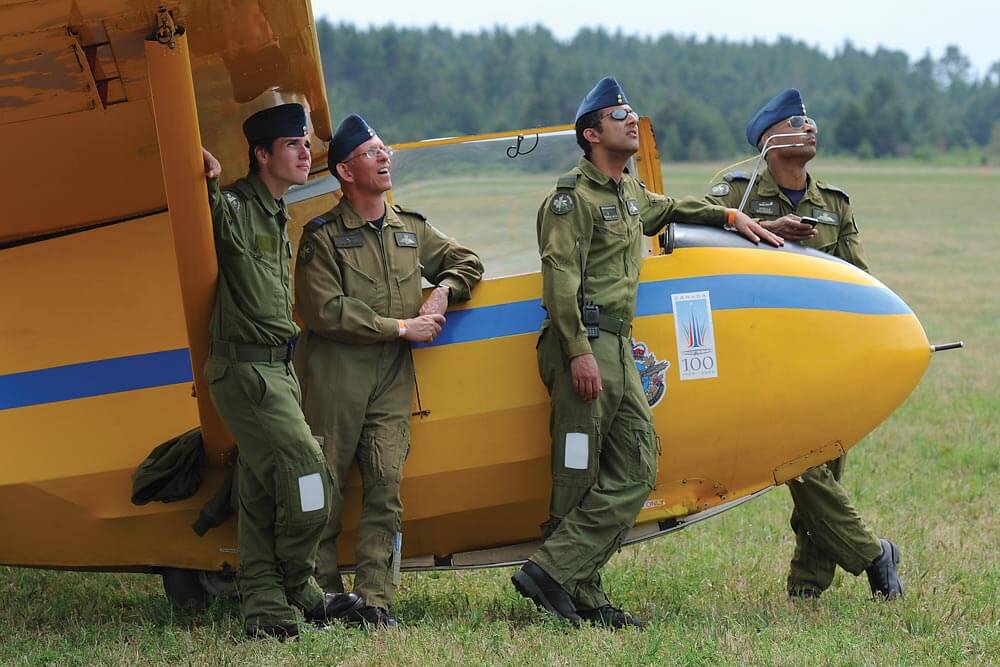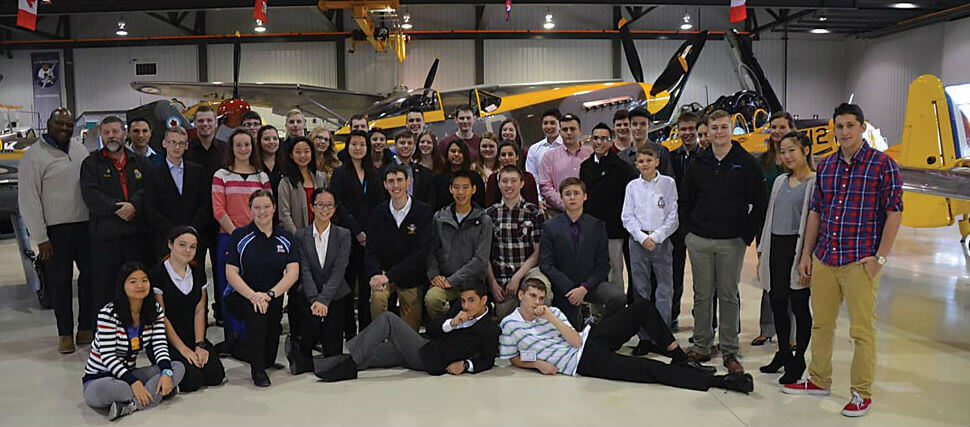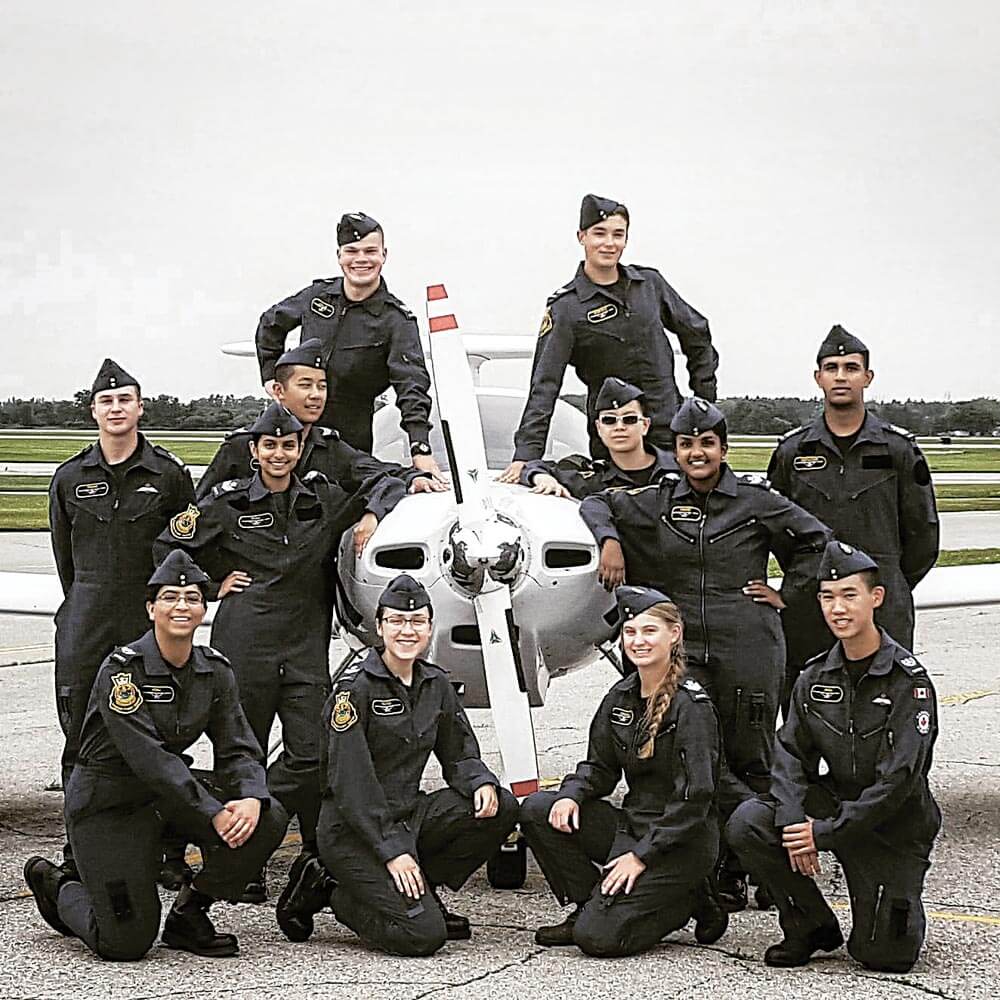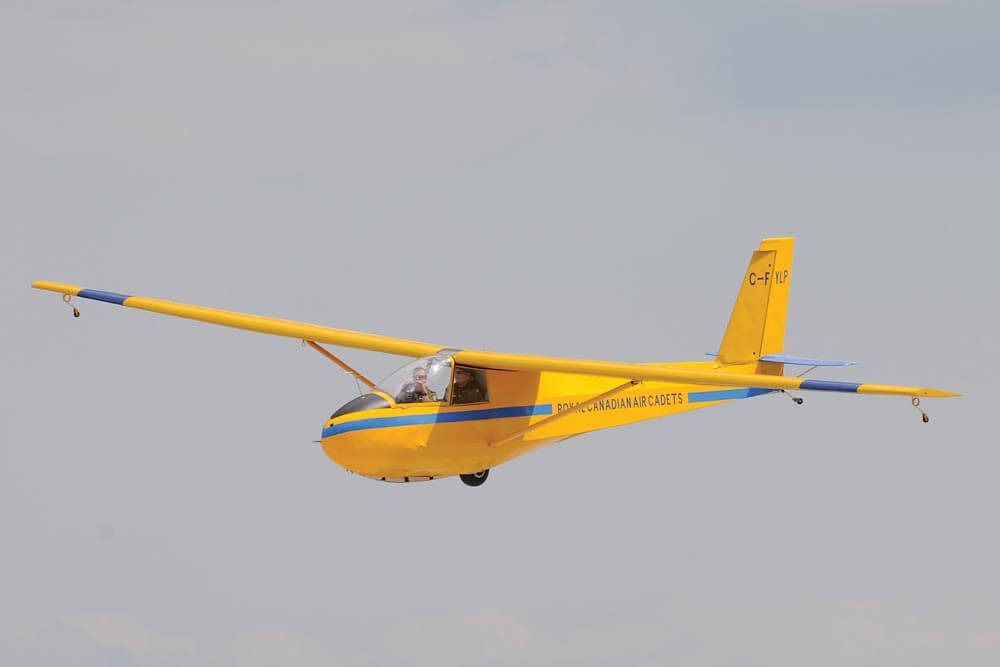Estimated reading time 13 minutes, 3 seconds.
This year marks an important milestone for the Royal Canadian Air Cadet (RCAC) program and the Air Cadet League of Canada, as they are celebrating their 75th anniversary.

To mark this important year, a gala commemorating the signing of the Charter that brought the air cadet movement to life took place at the Canada Aviation and Space Museum. Both past and present cadets were celebrated during an evening of entertainment, history and recognition.
Among the special guests that evening were 40 air cadets from across Canada, who had participated in a three-day Air Cadet Leadership Symposium during the few days leading up to the Saturday dinner. These air cadets have demonstrated their excellence, leadership and commitment to the ideals of the air cadet program, and were brought together to share their insights and ideas on the symposium theme, “The next 75 years of Air Cadets.”
But, before embarking on future planning, it is important to understand the past.
During the Second World War, there was a critical need for planes–and for trained young men to fly them. It was against this backdrop that the idea of preparing a select corps of teenaged boys to take their places as aircrew in the Royal Canadian Air Force (RCAF) grew. On April 9, 1941, the Air Cadet League of Canada was established to train young men for service overseas. Canada’s national flying ace, Air Marshal Billy Bishop, was among the organization’s founders.
By September 1944, the cadet movement had reached its peak wartime strength of 374 squadrons, more than 29,000 cadets, 1,750 officers and instructors, and another 2,000 civilians who supplied financial and other support. Within three years, the League had built a successful war effort air training program through an outstanding collaboration between military and civilian community partners.
During its formative war years, the League’s primary purpose was military. However, service clubs, educators, boards of trade and veterans groups quickly saw the League’s long-term role as a future civilian organization that could encourage Canadian youth to become good citizens and strong leaders. These remain pivotal goals for air cadets today.
One popular innovation was the introduction of the Power Flying Scholarship Program in 1946. Power flying courses continue to be offered during summer camps, where cadets are trained on powered light aircraft through civilian flying clubs. Since its inception, more than 18,000 air cadets have completed the program.

The unification of the Canadian Armed Forces (CAF) in the mid-1960s marked another significant shift for the League. Unification resulted in the closing or amalgamation of many air bases. Air cadets were no longer being provided with sufficient flight opportunities. In response to this reality, a gliding program was launched by the League in 1965.
Since that time, gliding has become an integral part of the cadet experience; on average, more than 50,000 glider familiarization flights are conducted each year, making it the largest glider program in the world. To date, more than 15,000 cadets have completed the course, with approximately 90 per cent graduating with the glider pilot designation.
Recent statistics reveal that one out of every five private pilots in Canada at the present time was a former air cadet. In addition, 67 per cent of the commercial airline pilots flying today got their start as an air cadet.
These numbers are a great testament to the important impact of Air Cadets on the careers of many Canadian pilots.
Here are just a few testimonials:
“My career in the RCAC was brief, yet rewarding. I joined the 177 Air Canada Squadron of the RCAC in 1975 to obtain my glider licence on the recommendation of a friend. I was selected for the 1976 gliding scholarship in Rivers, Man. During 1977, I was awarded the powered flight scholarship as well. I was awarded the “Top Cadet in Manitoba” at the conclusion of both courses. Currently, I am a qualified pilot holding an airline transport pilot licence (ATPL). Some highlights of my career: I have physically stood on both the North and South geographic poles; I operated in North and South America, Antarctica, Asia and Africa; and I have done ferry flights from Canada through Europe to Asia and Africa. Most of my career has been with turbine-powered propeller aircraft, notably the DHC-6 Twin Otter and the Dash 8. Seems that the “airline” type of flying was not my thing. I suspect I had more of an adventuresome spirit! Who knew that when I began with the Royal Canadian Air Cadet organization I would still be involved in aviation after 40 years! This year marks my 40th year as a pilot (1976-2016). I am thankful and grateful that I was selected to attend both gliding and powered flight scholarships. Thank you, Royal Canadian Air Cadets!” — Michael Kruger
“I joined the Air Cadets by following a friend who told me to go with him: it would be fun! So I followed him, joined, and was on 643 Squadron for five years. I then joined the Air Force as a pilot, got to fly F-18s, and left 12 years later to become a commercial pilot. I am now a Boeing 767 captain at Air Canada. All because of the Air Cadets! — Michel Mondou
“I started in 1950 with the Winnipeg Optimist Squadron and then Gordon Bell Squadron, where I received a scholarship in 1954 at the Winnipeg Flying Club. At the same time, I was in 402 Aux from 1953-55. In September 1955, I joined the RCAF and became a pilot; the selection was probably based on having a pilot licence. I remained in the RCAF until the summer of 1964. In the fall of 1964, I joined CP Air and retired in 1996 as a captain on the 747-400. As luck would have it, I was asked to be the reviewing officer of the Etobicoke squadron about 10 years ago. A nice finish to a flying career started with Air Cadets.” — William Davidson

“I joined No. 1 West Montreal Air Cadet Squadron in 1956 at the invitation of my best friend in high school, John C. Wilson, and I never looked back. My school academic record met the minimum standard to graduate, and was entirely opposite to my very successful four years in Air Cadets. I rose through the ranks to flight sergeant at retirement, collecting awards for the most proficient cadet three times, best rifle shot three times, power flying scholarship 1958 and 1959, and the international exchange visit to Britain. During the visit, I met the Queen Mother, Princess Anne, and Prince Charles, and sat in Douglas Bader’s (Film – Reach for the Sky) Spitfire at his base at RAF Tangmere. I joined the RCAF in 1959 and graduated with the coveted pilot wings in 1961. After 23 years in the RCAF and 14 years as a civil aviation inspector with Transport Canada, I retired with 10,500 hours in 26 types of aircraft and became a ground school instructor with 742 National Capital Air Cadet Squadron for eight years. I’m presently a member of the Air Cadet scholarship selection board in Ottawa and hope to assist in this function for many more years. I attribute my personal and professional success as a pilot to the training received in Air Cadets and regard the Air Cadet League as a priceless Canadian organization.” — Capt George E. Mayer
From the Schweitzer 2-33 to Afghanistan and back again:
Joining 246 Squadron of the Royal Canadian Air Cadets at the age of 12 changed the course of my life. The training gained at the squadron, combined with attending training camps every summer, develop cadets into disciplined members of society. In the spring and the fall, the Air Cadet gliding program conducts familiarization flights at gliding centres across the country using Bellanca Scout and Cessna L-19 tow planes and Schweitzer 2-33A gliders. I, like all Air Cadets, had the chance to complete familiarization flights and to take the controls of the glider while under the careful watch of senior cadets and instructors. Taking these first flights in a glider instilled the love of flying for many, including myself, and the desire to pursue further training. I was lucky enough to move on to the next step, which is the full glider scholarship program in Trenton. During this six-week course, 29 dual and 20 solo flights are completed, leading to a Transport Canada glider pilot licence. Thousands of Canadians in civilian aviation and the military, including astronauts Col Chris Hadfield and LCol Jeremy Hansen, started their flying careers with the Air Cadet glider pilot scholarship program. Many also go on to a power scholarship, leading to a private pilot’s licence.
The discipline gained through the Air Cadet program helped with my selection for the Royal Military College of Canada (RMC). RMC offers a degree consisting of four pillars: academics, physical fitness, second language training, and military training. The close group of friends you make at RMC will last a lifetime because you get through the program together, from the gruelling recruit obstacle course to graduation. Taking a wide variety of arts courses in addition to our full complement of engineering courses certainly didn’t make the challenge any easier. Summers consisted of second language training, primary flying training (Phase 1 of pilot training), and “on-the-job training” summers. I was able to go back to my roots with the Air Cadet gliding program and work as a glider instructor and tow pilot for the OJT summers.
Following graduation from the Royal Military College and commissioning as a second lieutenant, I was off to basic flying training (Phase 2) in Moose Jaw, Sask., to fly 100 hours on the CT-156 Harvard II aircraft. This is a turboprop aircraft with a 1,300-horsepower PT-6 engine. On this very demanding course, we learned clearhood (VFR flying including circuits and aerobatics), low level navigation at 500 feet AGL and 240 knots groundspeed, instrument flying, and formation flying. This course is where you really learn the fundamentals of military flying. At the end of the course, you are selected for helicopters, fast jet, or multi-engine aircraft. The needs of the forces come first, but they try their best to get everyone what they want.

Following selection, multi-engine and helicopter pilots return to Portage-la-Prairie, Man., for Phase 3 pilot training on the King Air C-90B or CH-139 Jet Ranger, and those selected for fast jet remain in Moose Jaw for further training on the Harvard II and then the Hawk for fighter lead-in training. The culmination of this level of pilot training results in the awarding of your Canadian Armed Forces pilot wings.
Following multi-engine training, I was posted to 436 Squadron in Trenton, Ont., to fly the CC-130H Hercules aircraft in the tactical airlift role. During this tour, I was able to use the valuable lessons learned in Air Cadets, RMC, and pilot training during four two-month deployments to Afghanistan. Commanding a four-engine turboprop aircraft, including crew and 90 passengers, while in a high-threat area of the world, at the age of 27, was only possible because of the high level of training I had received.
I then had the opportunity for an exchange posting with the United States Marine Corps flying the KC-130J Super Hercules tanker. The purpose of the exchange program is to share our tactics and procedures with other nations and bring lessons learned from other nations back to Canada. Following upgrade to aircraft commander, I was back in Kandahar for a seven-month deployment flying all roles with the KC-130J. This involved logistics runs (moving cargo and passengers), battlefield illumination with flares, air-to-air refuelling of Harriers conducting close air support, and aircraft delivered ground refuelling (refuelling helicopters and ground vehicles with the Herc with all engines running).
I now work in wing operations at 8 Wing Trenton as deputy of current operations and am learning another side of the aviation profession.
Air Cadets, and specifically the Air Cadet gliding program, instilled in me the love of flying and the self-discipline required to be successful at the Royal Military College and the pilot training within the Royal Canadian Air Force. Working in wing operations gives me the chance to return to my roots and fly the Bellanca Scout tow plane and instruct today’s Air Cadets on the Schweitzer 2-33A glider, while inspiring the next generation of cadets to pursue their own career in aviation or other life goals. “To learn; to serve; to advance.” – Capt Max Dares, deputy current operations, 8 Wing Trenton
Pilots are not the only ones who have benefited from the Air Cadets. As this other testimonial shows, being part of the organization can lead to many more careers in a variety of fields.
“I joined 666 Civitan Squadron in Toronto when I was 14, after seeing some cadets at the local mall for Tag Day. I asked them to tell me about the program and their enthusiasm and pride were so contagious that I wanted to be a part of that. We had a lot of glider and power pilots at the squadron, so in an effort to balance the skill set I went the leadership route. My time at Senior Leaders in Cold Lake, Alta., followed by the international exchange to Hawaii, were definite highlights of my time with cadets. I was the first female cadet in the history of the squadron to make chief. I went on to join the Royal Canadian Air Force and served as an aircraft maintenance engineer for 13 years and now, even in the private sector working as an aerospace professional, I draw on the leadership lessons that I learned while in the air cadets every day. I stay connected with the program and recommend it to youth at every opportunity. Recently, I served in the Air Cadet League’s Ontario Provincial Committee’s Board of Governors. — Eva Martinez
This year not only commemorates 75 years of a successful youth development program, but also all of those past and present air cadets that have developed or will develop into the great leaders and citizens of this country.
If you are a former air cadet who would like to share your story and join the Air Cadet alumni, visit www.aircadetleague.com.

Most interesting reading. Makes attending #394 meetings worth the
time well spent. Great to be invited to attend the Vaudreuil/
Dorion Cadet Squadron Reviews!
I enlisted in the Army Cadet Corp in Montreal High School in 1933
and attended school in full uniform (including putees!) one day a week. We Learned Semaphore signalling as well as rifle handling, shooting and many other activities. Sadly the family moved many miles away after my first year.